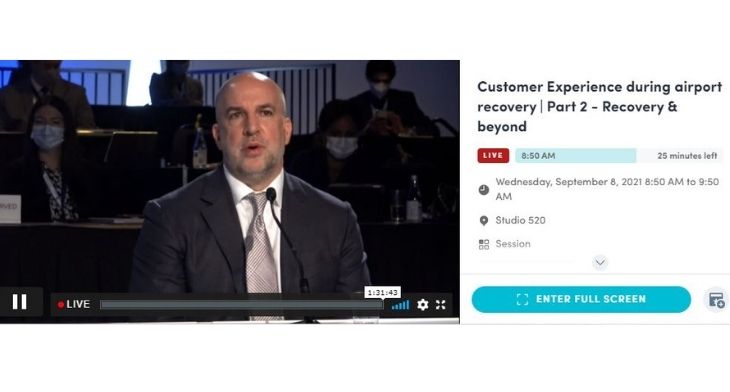


The demand for air travel is there but disparity between regulations and travel requirements in different regions is hampering a faster recovery. That was one of the key messages during a panel discussion on the customer experience during airport recovery, which took place on Wednesday 8 September as part of ACI World’s Customer Experience Global Summit.
The first day of the hybrid event, which has seen delegates and speakers attending in-person in Montreal, Canada as well as online has seen lively and insightful discussions on the importance of customer experience as airports prepare for a long and sustainable recovery following the COVID-19 pandemic.
Reach Airports’ new CEO, Andrew O’Brian, who previously oversaw operations at Quito Airport in Ecuador explained that in Latin America and the Caribbean “initially recovery has been driven by the diaspora wanting to reconnect with family and friends.” He also highlighted that in North America much of the outbound travel has been driven by customers seeking out destinations that are easy to travel to in terms of the new measures and testing requirements following the pandemic. He also highlighted the need as we enter this recovery period to ensure that all customers and their needs are being considered. “My mother is in her 80s and would love to get on a plane and see her kids and her grandchildren, but all the additional technology and travel requirements are a confusing prospect for someone who’s not necessarily a seasoned traveller,” he said.
Meanwhile Rafael Alberto Smith, Director of Terminal Operations/ Maintenance & Loading at Punta Cana Airport in the Dominican Republic said that unsurprisingly most of the passengers travelling through his airport are leisure travellers. With Punta Cana airport operated by Corporacion Aeroportuaria del Este (a private corporation run by Puntacana Resort and Club) the airport has been able to diversify by transferring some of its staff across the group’s accommodation facilities while air traffic has been reduced. The airport is also forecasting significant growth in inbound tourism for the winter months as travellers increasingly seek out winter sun destinations following the pandemic. Smith also commended the “excellent job” the Dominican Government has done with its vaccination programme in terms of facilitating the region’s recovery process.
Looking ahead, Jost Lammers, CEO and Chairman of the management board at Munich Airport, said that while different territories are recovering at different speeds there are certain elements of health and safety measures he believes will stay. “We need to reduce these measures as much as possible, but it will be one of the layers of air travel going forward,” he said.
Philippe Rainville, President and CEO of Aeroports de Montreal agreed saying that certain testing facilities installed at Montreal Airport for departing passengers will remain in place. “Country by country there will be some level of testing required as new pockets of disease arise.”
O’Brian urged the airport community to “stay positive,” as he said that at some point the World Health Organization (WHO) will declare the pandemic over. “When the pandemic first started, we had to adapt, be resilient and get creative. We’ve learned tremendous lessons along the way, but I hope all the protocols go and we can put this whole scenario behind us in a year or so.” One of the biggest lessons learned according to O’Brian is that health and space will be at the forefront of airport and terminal design going forward. “Airports have to consider where they will invest and how they will manage that. Everything is about the journey and keeping people safe and healthy.”
Johanne Gallant, President and CEO of Fredericton Airport, also expressed her hope that “everything will go back to normal as soon as possible.” However, she also believes that some elements will continue to be rolled out, such as the digital health pass. She also noted that while passengers will want to see regular cleaning and disinfectant measures some measures, such as physical distancing especially in smaller airports where space is at a premium are simply not practical. “Why are we continuing with social distancing in the terminal and at the gate when as soon as a passenger is on board the aircraft that doesn’t seem to apply?” she asked.
Rainville meanwhile stressed that with communication being key its now more important than ever for airports to be able to connect with their passengers as soon as their ticket is purchased. “We need a direct relationship with our passengers as soon as their flight is booked, so that we can answer their questions around travel and ensure that seamless journey. The technology is there to allow us to do this, it’s now about getting the airlines to work with us and provide us with access to passengers.”
Picking up on the point of communication being key, O’Brian underlined that “the 3 Cs – communication, collaboration and coordination – have never been so acute and important to the airport community.”
Reflecting on the lessons learned throughout the pandemic Gallant concluded: “We’re stronger and more resilient than we ever thought. It’s in the hard times that you see the true characters in your team. We’ve stuck together, we’re here to stay and grow and although we hope it won’t happen we’re far better prepared now should another pandemic come about.”
It was a sentiment that was echoed by her fellow panellists with Lammers adding that one of the key lessons he’s learned has been “to push harder and earlier”.
Smith wrapped up on a jovial note admitting that “other than lowering my handicap during lockdown, as a sector we have come out stronger and we have all realised we are capable of doing things we weren’t expected to do or thought capable of doing.”
Look out for the September issue of Regional Gateway magazine in which we feature an exclusive interview with Reach Airports CEO, Andrew O’Brian.





